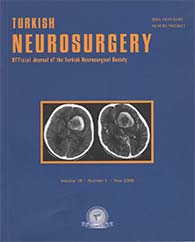3,4Kartal Eğitim ve Araştırma Hastanesi, Neurosurgery Department, İstanbul, Turkey
5,6Kartal Eğitim ve Araştırma Hastanesi, Neuroradiology Department, İstanbul, Turkey AIM: Computerized tomography (CT) has been the primary diagnostic instrument of neurosurgical centers for head injury until now. However, there is a subgroup of patients who have persisting neurological deficits without visible pathology on CT.
MATERIAL and METHODS: Between 2000 and 2002, 3000 patients were enrolled in this prospective study in emergency unit. There was a total of 124 patients (4.1%) who had persisting severe neurological deficits with normal findings on repeated CT scans. These patients underwent 1.5 Tesla cranial MRI study between posttraumatic days 2 and 10 (5.2±4.5). Data on epidemiological, clinical, radiological factors and final outcome were collected.
RESULTS: 76 (61.2%) of the patients were male and 48 (38.7%) were female. 113 (91.1%) of the 124 patients showed significant primary pathology on MRI study. The most common pathology was shear injuries in 75 (60.4%) followed by cortical contusion in 45 (36.2%) cases. 27 (21.7%) patients showed primary brain stem lesions and 8 (0.6%) patients showed subcortical gray matter lesions. 32 patients showed mixed lesions. There was one traumatic aneurysm detected.
CONCLUSION: The MRI examination in head injury is informative in detecting subtle lesions when the neurological condition cannot be explained by CT.
Keywords : Computed tomography, Magnetic resonance imaging, Severe head injury, Shear injury




